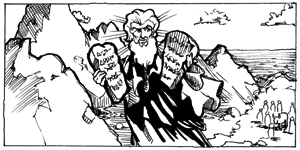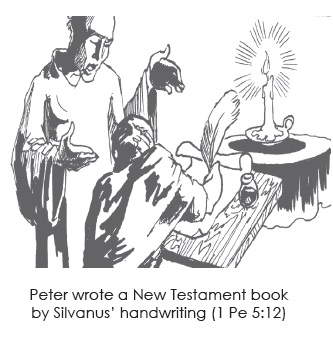|
|
|
Who wrote the Bible?
"men moved by the Holy Spirit spoke from God" 2 Pe 1:21 It was written by the Holy Spirit

First and foremost, the whole Bible was written by the Holy Spirit, meaning God. For example: “But know this first of all, that no prophecy of Scripture is... one’s own interpretation, for no prophecy was ever made by an act of human will, but men moved by the Holy Spirit spoke from God” (2 Pe 1:20, 21). So the Bible is not an interpretation of men, but instead a revelation of God’s will through men. That is why we consider it inspired by God.
The Old Testament
God inspired the Old Testament. Even His own finger wrote ten very important commandments on two tablets of stone and He gave them to Moses to give to the people (Ex 31:18; De 9:10). Then God led Moses to write some of the first five books of the Old Testament, if not all five. These are called the Law, or the Law of Moses because he is the one who received it from God to write it down and pass it on to the Jewish people (Ex 24:4; 31:18; 32:19, 34:1, 27, 28).
Note: In many verses, the New Testament refers to the Law of Moses when it teaches that it is not in effect any more because Jesus Christ fulfilled or completed it (SEE Mt 5:17; Col 2:14; Ro 8:3, 4; Ro 10:4; Ac 15).
Several other inspired men wrote the rest of the Old Testament. For example, Solomon wrote most of the book of Proverbs, the Song of Solomon, and Ecclesiastes (Pr 1:1; Ec 1:1; Sol 1:1). King David wrote most of the book of Psalms, which were songs about his joys, sorrows, and needs. He also spoke of the Christ in them (Ps 2:7; Ps 22). Several other prophets spoke words from God that were written down; men such as Isaiah, Jeremiah, and Ezekiel. King David was also called a prophet (Ac 2:29, 30; 2 Sa 23:1, 2). Others contributed to the writings. The Jews were the keepers and collectors of these Old Testament writings. All of them have been copied and translated over the years and delivered to us today.
The New Testament
Evidently or traditionally, the 27 books in the New Testament were written by eight inspired men; seven were Jews, but Luke supposedly was a Gentile.
1. Paul (a tent-maker) wrote 14 books 2. John (a fisherman) 5 books 3. Luke (a physician) 2 books 4. Peter (a fisherman) 2 books 5. Matthew [Levi] (a tax-collector) 1 book 6. James (a carpenter) 1 book 7. Mark (unknown) 1 book 8. Jude (a carpenter) 1 book
These books were written between 33 A.D. and 120 A.D. in the Greek language of that day, and were circulated amongst Christian churches. For example, Paul said, “When this letter is read among you, have it also read in the church of the Laodiceans” (Col 4:16). In his first letter to Timothy, in 5:18, Paul quotes from Matthew or Luke (Mt 10:10; Lk 10:7). So evidently Matthew’s and/or Luke’s Gospel account must have been circulated during the first century.
The credibility of the New Testament writers
Four were apostles of Christ
The apostles were chosen by the Messiah Himself to be eyewitness companions of His majesty when He was on the earth (Lk 6:13; Mk 3:14; 1 Cor 12:28; 2 Cor 12:12). In this way, they could be the best witnesses to credibly tell others about the Lord. Matthew, John, and Peter were apostles in that sense. Paul also was chosen by the Messiah to be an apostle (1 Tim 2:7). Yet Paul only saw Jesus in a vision (Ac 9:1-7). But the Lord used Paul mightily to spread the gospel, perhaps equally or even in greater measure than some of the other apostles. He wrote 14 out of 27 books, over half of the New Testament.

Two were traveling companions of an apostle of Christ
Of the men who went with Paul on his evangelistic journeys, two of them wrote New Testament books; Mark (Ac 12:25), also called John [not John the apostle], and Luke, the beloved physician. Now Luke, when writing the book of Acts, sometimes used the word “we” to indicate that he was with Paul (Ac 16:10; 27:2, 37). Both Mark and Luke would have understood first hand from this apostle what the new message was all about.
Traditionally, two were relatives of Jesus Christ, His brothers
The Messiah had brothers who, at some point, were followers of Him, James and Jude (Mk 6:3; Ac 1:14; Ga 1:19). Therefore, they would be credible witnesses and writers of their New Testament books. In A.D. 397, the Council of Carthage gave their formal acceptance of the 27 books in the New Testament, books that were already being used by the churches as the standard of Christian faith.
Conclusion
Even though both testaments were written by several inspired men from different ages, each book of both the Old and New Testaments fits together like a finished puzzle. They are woven together like one multi colored cloth, showing forth a unified picture of past, present, and future, especially in regards to the Messiah. This inspires our awe and wonder.
BACK TO INTRO HOME PAGE Website & Bible study content Copyright 2001-2010, © Patrick David Yanello, All rights reserved. |